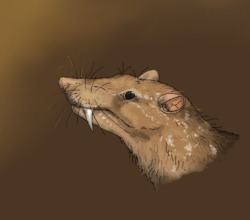Rank Order | Phylum Chordata Subclass Theria | |
 | ||
Similar Theria, Deltatheridium, Stagodontidae | ||
Deltatheroida is an extinct group of basal metatherians that were distantly related to modern marsupials. The majority of known members of the group lived in the Cretaceous; one species, Gurbanodelta kara, is known from the late Paleocene (Gashatan) of China. Their fossils are restricted to Central Asia and North America. This order can be defined as all metatherians closer to Deltatheridium than to Marsupialia.
Contents
These mammals possessed tritubercular lower molars and these were not tribosphenic and were quite primitive. This is awkward because tribosphenic molars are commonly found in most therian mammals (there exist some exceptions such as anteaters and some whales, which have no teeth at all).
When they were first identified in the 1920s, they were believed to be placentals and possible ancestors of the "creodonts" (a polyphyletic group of extinct carnivorous mammals from the Paleogene and Miocene), but this was later disproven. Nonetheless, deltatheroideans do converge on hyaenodontids, oxyaenids, carnivorans, dasyuromorphs and sparassodonts in many details of their dental anatomy, suggesting a carnivorous lifestyle.
Taxonomy
The following is a species list of Deltatheroida.
†Deltatheroida Kielan-Jaworowska 1982 [Deltatheralia Marshall & Kielan-Jaworowska 1992; Holarctidelphia Szalay 1993]
Biology
Deltatheroideans are thought to be carnivorous mammals, converging on hyaenodontids, oxyaenids, carnivorans, dasyuromorphs and sparassodonts in many details of their dental anatomy, suggesting a carnivorous lifestyle. Oxlestes and Khuduklestes in particular are among the largest mammals of the Mesozoic, though at least the former's status as deltatheroideans is questionable.
Deltatheroideans in this regard appear to have replaced eutriconodont mammals as the dominant carnivorous mammals of the Mesozoic, either directly through competition or occupying vacant ecological niches; in North America, Nanocuris came to succeed the larger gobiconodontids and Jugulator, while in Asia the Early Cretaceous gobiconodontid radiation is replaced in the Late Cretaceous by a deltatheroidean one. Given that all insectivorous and carnivorous mammals groups suffered heavy losses during the mid-Cretaceous, it seems likely these metatherians simply occupied niches left after the extinction of eutriconodonts.
Evidence of direct predation on dinosaurs may be attested on a skull belonging to Archaeornithoides, which seems to have been punctured by Deltatheridium teeth and later healed.
At least some deltatheroideans were sabertoothed predators.
